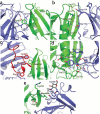Structural basis for receptor recognition by New World hemorrhagic fever arenaviruses
- PMID: 20208545
- PMCID: PMC2920743
- DOI: 10.1038/nsmb.1772
Structural basis for receptor recognition by New World hemorrhagic fever arenaviruses
Abstract
New World hemorrhagic fever arenaviruses are rodent-borne agents that cause severe human disease. The GP1 subunit of the surface glycoprotein mediates cell attachment through transferrin receptor 1 (TfR1). We report the structure of Machupo virus (MACV) GP1 bound with human TfR1. Atomic details of the GP1-TfR1 interface clarify the importance of TfR1 residues implicated in New World arenavirus host specificity. Analysis of sequence variation among New World arenavirus GP1s and their host-species receptors, in light of the molecular structure, indicates determinants of viral zoonotic transmission. Infectivities of pseudoviruses in cells expressing mutated TfR1 confirm that contacts at the tip of the TfR1 apical domain determine the capacity of human TfR1 to mediate infection by particular New World arenaviruses. We propose that New World arenaviruses that are pathogenic to humans fortuitously acquired affinity for human TfR1 during adaptation to TfR1 of their natural hosts.
Conflict of interest statement
The authors declare no competing financial interests.
Figures





Similar articles
-
Machupo virus glycoprotein determinants for human transferrin receptor 1 binding and cell entry.PLoS One. 2011;6(7):e21398. doi: 10.1371/journal.pone.0021398. Epub 2011 Jul 7. PLoS One. 2011. PMID: 21750710 Free PMC article.
-
New world clade B arenaviruses can use transferrin receptor 1 (TfR1)-dependent and -independent entry pathways, and glycoproteins from human pathogenic strains are associated with the use of TfR1.J Virol. 2008 Jan;82(2):938-48. doi: 10.1128/JVI.01397-07. Epub 2007 Nov 14. J Virol. 2008. PMID: 18003730 Free PMC article.
-
Transferrin receptor 1 in the zoonosis and pathogenesis of New World hemorrhagic fever arenaviruses.Curr Opin Microbiol. 2011 Aug;14(4):476-82. doi: 10.1016/j.mib.2011.07.014. Epub 2011 Jul 30. Curr Opin Microbiol. 2011. PMID: 21807555 Free PMC article.
-
The curious case of arenavirus entry, and its inhibition.Viruses. 2012 Jan;4(1):83-101. doi: 10.3390/v4010083. Epub 2012 Jan 13. Viruses. 2012. PMID: 22355453 Free PMC article. Review.
-
New World Arenavirus Biology.Annu Rev Virol. 2017 Sep 29;4(1):141-158. doi: 10.1146/annurev-virology-101416-042001. Epub 2017 Jun 23. Annu Rev Virol. 2017. PMID: 28645238 Free PMC article. Review.
Cited by
-
Structure and dynamics of drug carriers and their interaction with cellular receptors: focus on serum transferrin.Adv Drug Deliv Rev. 2013 Jul;65(8):1012-9. doi: 10.1016/j.addr.2012.11.001. Epub 2012 Nov 23. Adv Drug Deliv Rev. 2013. PMID: 23183585 Free PMC article. Review.
-
Antibody-Based Inhibition of Pathogenic New World Hemorrhagic Fever Mammarenaviruses by Steric Occlusion of the Human Transferrin Receptor 1 Apical Domain.J Virol. 2021 Aug 10;95(17):e0186820. doi: 10.1128/JVI.01868-20. Epub 2021 Aug 10. J Virol. 2021. PMID: 34132574 Free PMC article.
-
Evolutionary reconstructions of the transferrin receptor of Caniforms supports canine parvovirus being a re-emerged and not a novel pathogen in dogs.PLoS Pathog. 2012;8(5):e1002666. doi: 10.1371/journal.ppat.1002666. Epub 2012 May 3. PLoS Pathog. 2012. PMID: 22570610 Free PMC article.
-
Differential Antibody-Based Immune Response against Isolated GP1 Receptor-Binding Domains from Lassa and Junín Viruses.J Virol. 2019 Apr 3;93(8):e00090-19. doi: 10.1128/JVI.00090-19. Print 2019 Apr 15. J Virol. 2019. PMID: 30728269 Free PMC article.
-
LCMV glycosylation modulates viral fitness and cell tropism.PLoS One. 2013;8(1):e53273. doi: 10.1371/journal.pone.0053273. Epub 2013 Jan 7. PLoS One. 2013. PMID: 23308183 Free PMC article.
References
Publication types
MeSH terms
Substances
Associated data
- Actions
Grants and funding
LinkOut - more resources
Full Text Sources
Other Literature Sources
Molecular Biology Databases

